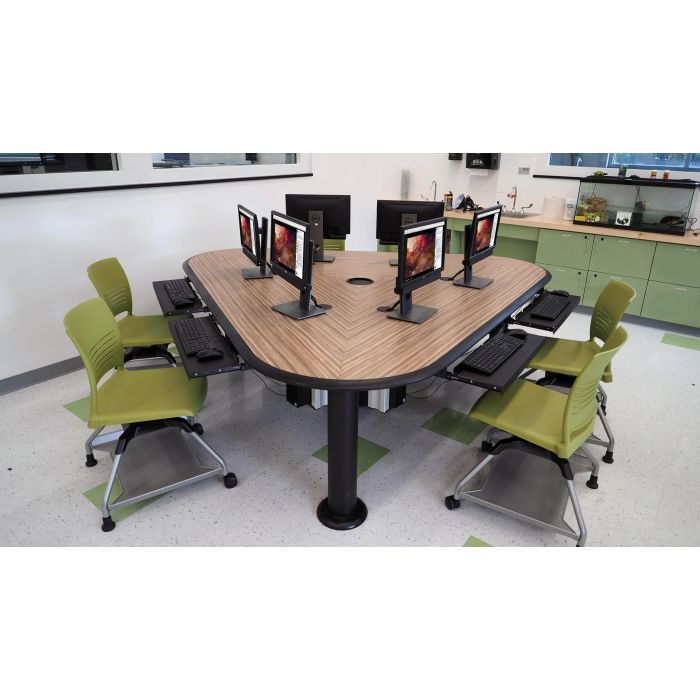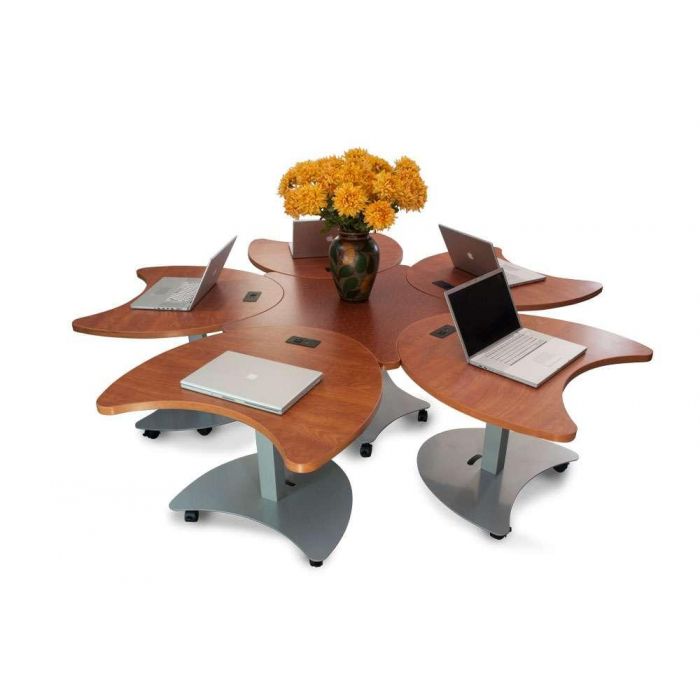What Is the Best Classroom Layout for Learning?
Classrooms with collaborative furniture creates a better learning environment for students. These improvements help achieve higher participation rates and improved learning outcomes. Accomplishing a collaborative desk layout is difficult to do with traditional desks. Tables with fixed chairs are hard to rearrange. According to research conducted by Yale University, students prefer mobile desks and chairs, a preference that supports instructors’ goals, too. The best classroom for learning is one that fits the class’s goals. Here’s how to find the best layout for your classroom and the right furniture to encourage learning.
Why Is Seating Arrangement Important in Classrooms?
Classroom arrangement significantly impacts student learning outcomes. Consider the differences between a traditional lecture hall, a round table, and a group pod layout.
Lecture halls place all attention on the presenter.
● Pro: Reduces distractions.
● Con: Creates barriers to collaboration.
Round tables place each student and instructor on an equal level.
● Pro: Fosters a welcoming environment for discussions.
● Con: Shyer students may need to adjust to facing other students.
Group pods place students together in small teams.
● Pro: Promotes collaboration.
● Con: May increase distractions.
The effects of the seating arrangement in a classroom depend on its layout. Different layouts help achieve different learning outcomes. Creative solutions like utilizing collaborative furniture allows instructors to adjust their classrooms for changing goals.
What Is the Psychology of Classroom Seating?
Classroom seating impacts students psychologically and affects participation and performance. The characteristics of a positive classroom environment are:
● Participation: Students answer questions, complete assignments, and contribute to discussions.
● Performance: Students show proficiency in the course material.
● Engagement: Students interact with their teachers and classmates. Students also show interest in the course material.
Research published by the U.S. Department of Education reports that students learn the best in classrooms with horseshoe seating, an arrangement that improved test scores and class participation. The researchers also asked students about their experiences in a horseshoe, small group, and desk pair format. Here are a few key points of what they had to say:
● Students preferred sitting in a small group or desk pair layout by a small margin.
● Students felt that they were able to participate the most in a horseshoe layout.
● Students felt that they could work with their classmates more easily in a desk pair layout.
Each layout presents different benefits for students and instructors. Adaptable classrooms are ideal for learning environments because they meet changing needs. For example, Exchange Active Learning Desks are a modular option that is easy to rearrange and provides access to technology. We will take a closer look at these pieces of collaborative furniture in the next section.
Exchange Active Learning Furniture
Exchange Active Learning Desks provide access to technology on wheels, giving each student the tools they need to learn. These desks are also easy to rearrange into a layout that best meets your classroom’s needs. Additional features include:
● A unique shape to enable layouts like desk pair, arrow, horseshoe, individual, and more.
● FlipIT monitor mounts for immediate tech access and convenient storage.
● Sliding keyboard trays to keep desks clear and distraction-free.
Exchange Active Learning Desks and other pieces of collaborative furniture make it possible to match classroom layout to students’ learning styles. Benefits include improved performance outcomes and increased student interaction with each other, instructors, and course material.
What Is the Best Layout for a Classroom?
The best classroom layouts for effective learning are ones that are mobile as classroom activities are subject to change. Traditional layouts work well when hosting a guest speaker. Group layouts enable students to find solutions together. Round tables encourage more students to participate in discussions. Yale’s Poorvu Center for Teaching and Learning analyzes six types of classroom structures and their engagement levels.
● Traditional: This layout increases engagement for students in the front or middle of the classroom. Students seated near the back tend to be less engaged. Pi Laptop and Computer Tables fit traditional layouts and equip students with technology.
● Round Table: This layout distributes engagement more evenly. More outgoing students may participate more. iGroup Collaborative Furniture easily rearranges into pinwheel formations for discussions.
● Horseshoe: This layout increases engagement with students who are directly facing the instructor. Students on either side of the horseshoe may be less engaged. Exchange Active Learning Table fit together in pods or split apart for horseshoe and other formations.
● Double Horseshoe: This layout is similar to a horseshoe, except desk pairs replace individual desks. Students who are directly facing the teacher participate more often. Students can also engage with their peers who are sitting next to them. iLid Flip Screen Desks fit two students each with built-in tech.
● Group Pods: This layout is ideal for many projects and encourages teamwork between small groups of students. Quark2 Mobile Desks easily connect into groups of up to five students.
● Pair Pods: This layout makes it easier for students to interact with the other member of their pod. Doing so helps both students engage with the course material. Trapeza Collaborative Learning Tables fit up to two students each or combine into triangles to fit six students in a group.
Each layout brings different benefits and drawbacks. Modular furniture enables instructors to transform their classrooms to meet the day’s learning objectives.
Collaborative Learning in Action with SMARTdesks!
The University of Notre Dame, Mendoza College of Business makes the most out of their knowledge center with SMARTdesk collaborative furniture. The knowledge center encourages participation by providing access to technology in a group setting. One of the keys to collaboration is flipIT computer monitors that fold up from each desk, allowing for quick access and easy, out-of-way storage. Piatto Conference Tables come with flipIT monitors and preserve line-of-sight to presenting areas.
Furniture dictates room layout. Collaborative furniture encourages people and ideas to move about instead of staying siloed. For more classroom layout ideas, explore our collection of collaborative furniture. Start designing custom pieces today!



